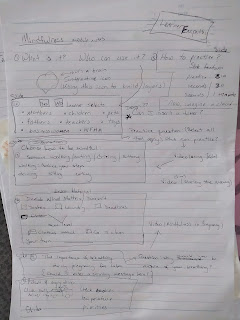Storytelling
How does developing learner empathy help me design an optimal learner experience?
Parrish (2006) calls it a necessary skill for IDs, a "dramatic rehearsal".
The design story calls for a character, who the ID follows along their instructional journey. In first-person viewpoint, describe the experience of the learner including their atmosphere, thoughts, external factors.
- Quick record (don't spend much time on details)
- Present tense
- Inhabit the learner
- Use empathetic imagination
Design perspective: Who is my learner? A working mother who wants to manage her stress better.
What's her story? Inhabit the learner. When does she take the course? Why? With what expectation? What are her surroundings when taking the course? Describe her disposition.
When does it benefit me most in this project to create the design story?
Answer: During the Design phase (Parrish 2006)
Learner: Pam. She's a work-from-home mother to her two-year-old daughter while also managing an online business. She spends plenty of time in front of the screen, but she'd like to discover ways not to feel so frazzled all the time. Her partner joins her in meditation when he isn't working.
This course is aimed to teach Pam how to practice mindful living in her day-to-day activities, so that "being mindful" doesn't feel like a chore. She feels proud of herself for enrolling in the course, but pessimistic about its ROI. But she wants to take her first step.
Within the first two slides, Pam is introduced to mindfulness. She sees a woman character, which makes her relatable. She's asked to interact, which is helpful for her to engage and hold her attention. She gets to try it on herself and is given some useful tools.
The course should be interactive, simple, straight-forward. But lighthearted. Throwing in a few practice "quizzes" in the form of a wrap-up question is great after showing a video so she can practice what she learned.
Reflection: I like that building the module through the eyes of the character helps me focus better. It's as if I'm designing the course as if I'm taking it as her, and want to imagine her experience so that I can make it better.
As a working mother, then, what information can help her feel less stressed and more relaxed about situations. For me, mindfulness reminds me that I can't pour from an empty cup. And, as a mother, its vital for me to replenish myself to avoid burnout. Also, I'm selective with where I give my energy.
Are YouTube videos allowed, or are we expected (for this course) to produce all video footage?
Design idea: Image of a brain on a slide. Learner: How can you declutter the mind? Prompts student to click __ (something clever) for more information.

Comments
Post a Comment